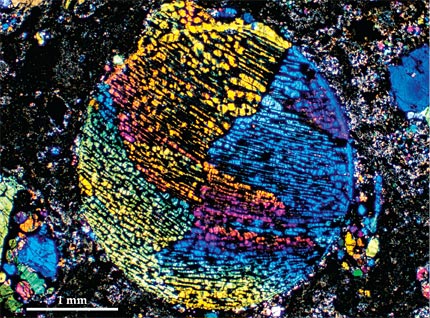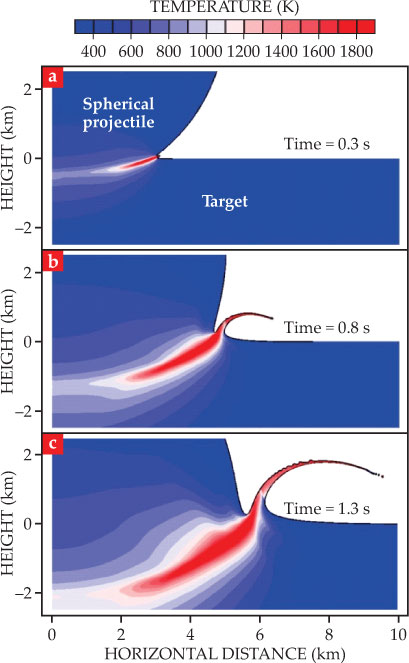Giant impacts may explain the origin of chondrules
DOI: 10.1063/PT.3.2708
Chondrules, such as the one shown in figure 1, are millimeter-scale, previously molten droplets that make up more than half the volume of most meteorites that fall to Earth. Isotopic dating suggests they formed during the roughly 5 million years when the solar nebula was coalescing into solids (see the article by Robin Canup, Physics Today, April 2004, page 56

Figure 1. Crack open a meteorite and you’ll probably find chondrules whose chemical compositions, millimeter-scale diameters, and igneous textures—the shapes, appearance, and crystal orientations of the mostly olivine and pyroxene minerals—constrain any compelling model of chondrule formation. Shown here sliced wafer thin and viewed in polarized light, this richly colored chondrule was embedded in a meteorite known as Maralinga. The barred texture shows the orientation of olivine crystals. The chondrule is surrounded by other inclusions and a fine-grained matrix (black) of mineral fragments. (Courtesy of Laurence Garvie, Center for Meteorite Studies, Arizona State University.)

Other theories posit collisions between asteroids as the source of chondrule-forming droplets. The idea goes back to the 1950s and gained traction a decade ago when planetary scientists realized that asteroids could grow as large as the Moon within tens of thousands of years—a much shorter time than the millions of years previously believed. But the drag on bodies from nebular dust and gas should slow their relative speeds to just a few kilometers per second, too slow to melt solid objects in a collision. And even if the bodies were to somehow collide fast enough to melt, such events would produce far more fragments of broken rock than melted rock, which doesn’t match the meteorite record. 1
MIT postdoc Brandon Johnson, his former Purdue University thesis adviser Jay Melosh, and their colleagues now propose an often overlooked process known as impact jetting that overcomes those objections and revives the plausibility of a solid-collision origin. 2 The process describes the high-speed squirting of superheated solid, molten, and gaseous debris from the explosive collision of two objects whose curved or irregular surfaces close together like scissors blades. Long exploited in military applications—impact jetting explains how an armor-piercing bazooka rocket works—the pinching of material generates up to several times the pressures encountered in planar impacts. Simulating the jetting process at high spatial resolution is computationally expensive, though, and the MIT–Purdue researchers are the first to numerically resolve it in a planetary context.
Blobs and droplets
Jetting isn’t the only process that can melt relatively slow-moving bodies. The decay of short-lived radioisotopes, such as aluminum-26, whose daughter product, magnesium-26, is found in the most ancient meteorites, would supply more than enough heat to populate the solar nebula with molten asteroids. And the inevitable splashing of any one of them during even low-speed collisions would spew out magma as great plumes of droplets.
But chemical differentiation, which happens as dense metals sink to the center of a large enough body, particularly one already molten, would alter the splashed melt’s composition. Chondrites, by contrast, contain dense metal and reflect the primitive, undifferentiated composition of the solar nebula. Moreover, while working on another project last year, Johnson and Melosh realized that splashing among molten asteroids would produce liquid blobs roughly 40 m in diameter—hardly droplets.
At the time, the pair were running simulations of droplet-forming, crater-making impacts,
3
such as the dinosaur-killing Chicxulub impact 65 million years ago (see Physics Today, May 1982, page 19
The researchers were puzzled, however, at what mechanism might give rise to the melt needed to make the chondrules, given the constraint of slow collision speeds in the solar nebula. Melosh wondered if the porous nature of rocky asteroids might account for it, since the rock should heat up during compression just like air in an inflating bicycle tire. Johnson, meanwhile, hit on impact jetting.
High-speed jets
Johnson simulated the effect for a variety of embryos, large and small, at a range of collision speeds. When the edge of a spherical projectile collides with and penetrates either a flat plate, as shown in figure 2’s simulation, or another embryo, he found that the resulting high pressures—exceeding 80 GPa in some cases—and nearly 2000-K temperatures can create a pocket of melt and vapor next to the near vacuum of outer space. 2 , 4 The enormous pressure gradient then accelerates a plume of molten rock and gas into the nebula at speeds well above the impact velocity.

Figure 2. A spherical projectile 10 km in diameter collides with a rectangular slab at 3 km/s. (a) As the projectile penetrates the slab, molten material (red) forms within 0.3 second at the edge of the contact region of the two. (The origin in this two-dimensional simulation is the point of collision.) (b) A well-formed jet develops within 0.8 s and squirts a plume of melt, gas, and lightly shocked rock from the edge. (c) As the projectile penetrates the plate, the jetting region moves rightward, following the edge of the projectile. The fastest ejecta reach a velocity of 6 km/s, twice the impact velocity. (Adapted from ref.

The ejecta’s speed explains how the impacts—which spew much more, but slower, broken rock than melt—can end up making chondrule-rich meteorites. The only material that escapes the gravitational pull of the embryo, the researchers argue, is a jetted mixture of melt (nascent chondrules) and lightly shocked solids in which the chondrules eventually become embedded. And although the amount of melt squirted into space turns out to be small—just 1% of the impactor’s mass—Johnson’s simulations reveal that collision speeds as low as 2.5 km/s can create it.
To place the jetting model into a planetary context, Purdue University’s David Minton simulated the orbital dynamics of bodies that would grow to become the planets and asteroids we see today. Starting with a reasonable mass of planetary embryos, whose initial size distribution ranged from 100 km to 1000 km in diameter, he used his simulations, supplemented with a lookup table from Johnson’s jetting results, to estimate the locations, frequency, sizes, and velocities of potential chondrule-forming impacts. 2 Those impacts began occurring a few thousand years into the simulation and continued for millions of years, a time span consistent with the life span of the nebula and the spread of ages found among real chondrules dated isotopically.
The simulation’s conservative estimate of 1023 kg for the accumulated melt made by jetting is several times greater than the mass thought to reside in the asteroid belt, says Johnson. And his separate calculation of likely droplet sizes—determined by the balance of surface tension and inertial forces acting on the accelerated plume of gas and melt— reproduced a millimeter-scale distribution over a wide range of impactor sizes. Together, the results explain the chondrules’ abundance in meteorites.
A reinterpretation
According to the impact-jetting theory, chondrules emerge from much larger bodies and preferentially accrete onto smaller ones, which have a larger collective surface area. That logic led the MIT–Purdue collaboration to a succinct conclusion stated in the final line of their paper: “Chondrules are not the direct building blocks of the planets, but merely a byproduct of their accretion.” 2
“That statement has outraged meteoriticists more than anything we could have said or done,” says Melosh. “It had been believed that with up to 95% of chondrites chock-full of them, chondrules must be those building blocks, and generations of researchers have put the motherhood statement in their grant proposals. We’re denying that and arguing that while chondrules are certainly part of the construction debris, they’re not the main game.”
That interpretation doesn’t change the fact that meteorites reflect conditions in the early solar nebula. Rather, the new model is diagnostic of the process—how and in what environment our solar system was built. “Although more work is needed to investigate and test the new model,” says the University of Chicago’s Fred Ciesla, “it’s likely to open a debate I expect to continue for years.”
References
1. For reviews of chondrule-formation models, see S. J. Desch et al., Meteor. Planet. Sci. 47, 1139 (2012); https://doi.org/10.1111/j.1945-5100.2012.01357.x
I. S. Sanders, E. R. D. Scott, Meteor. Planet. Sci. 47, 2170 (2012); https://doi.org/10.1111/maps.12002
F. J. Ciesla, in Chondrites and the Protoplanetary Disk, Astronomical Society of the Pacific conference series vol. 341, A. N. Krot, E. R. D. Scott, B. Reipurth, eds., ASP (2005), p. 811.2. B. C. Johnson et al., Nature 517, 339 (2015). https://doi.org/10.1038/nature14105
3. B. C. Johnson, H. J. Melosh, Icarus 228, 347 (2014). https://doi.org/10.1016/j.icarus.2013.10.022
4. For details, see B. C. Johnson, T. J. Bowling, H. J. Melosh, Icarus 238, 13 (2014). https://doi.org/10.1016/j.icarus.2014.05.003
